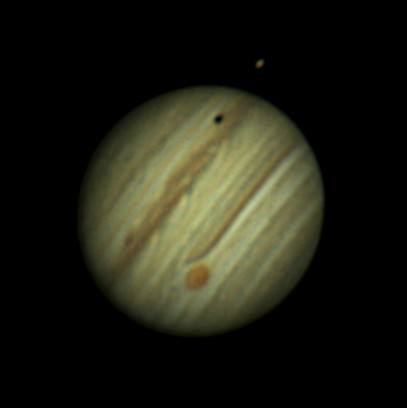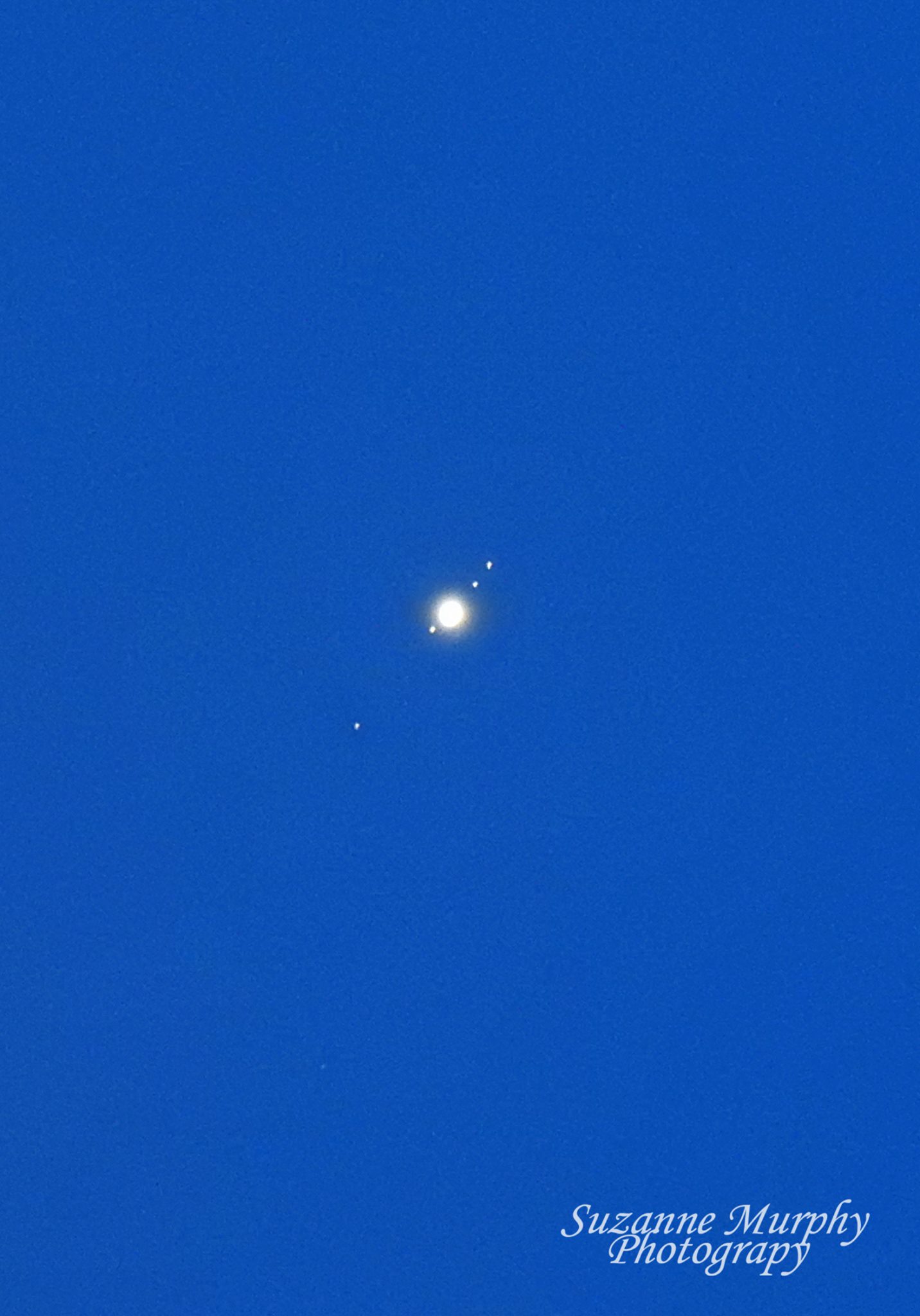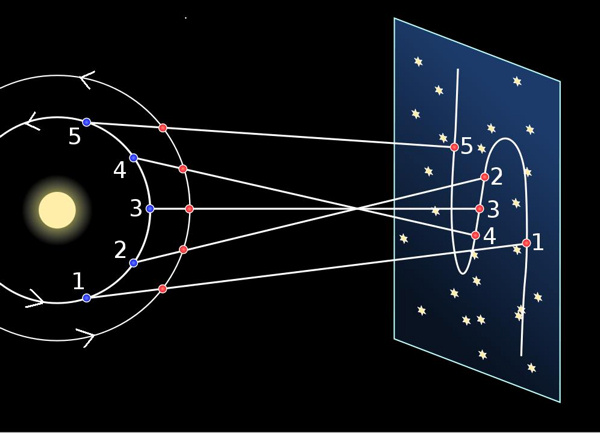Tonight – July 10-11, 2018 – the planet Jupiter is poised in front of the stars of the zodiac. It’s now moving neither east nor west against the star background, but will soon resume its usual eastward course. In other words, Jupiter is stationary on July 11 at 04:00 UTC. In United States time zones, Jupiter reaches its stationary point on July 11 at 12 midnight EDT, and on July 10 at 11 p.m. CDT, 10 p.m. MDT, 9 p.m. PDT, 8 p.m. Alaskan Time and 6 p.m. Hawaiian time.
Are you in the Northern Hemisphere? Then look for this brilliant beauty of a planet high in the south to southwest sky as soon as darkness falls.
Southern Hemisphere? From mid-latitudes in the Southern Hemisphere, Jupiter appears high overhead or high in the northern sky at early evening.
Learn: How to see Jupiter’s moons

Jim Powell of Whiteville, North Carolina, captured this image of Jupiter through his telescope on June 8, 2018. Look in about the 1 o’clock position for the shadow of one of Jupiter’s moons on Jupiter’s cloudtops.
The end of retrograde motion for Jupiter marks the end of the best time of 2018 to see this planet. And yet you might not believe it if you gaze at Jupiter tonight. It’s still incredibly bright, brighter than any star in the evening sky. Jupiter is normally the second-brightest planet, after Venus. Only the sun and moon outshine them … usually.
Wait one minute, though. The planet Mars – soon to be closest to Earth, and brightest in our sky, since 2003 – is now brighter than Jupiter. You can’t mistake Mars for Jupiter because Mars is so reddish in color. Jupiter is at about its highest in the sky after sunset. Mars can be found a bit later, ascending in the eastern sky by mid-to late evening, as Jupiter is sinking westward. For about two months – around July 7 to September 7, 2018 – Mars supersedes Jupiter in brightness. Mars and Jupiter will be close to the same brightness at the beginning and ending of this period of time … in other words, around now.
Later this month, when Mars reaches opposition, it’ll be nearly twice as bright as Jupiter (more precisely: 1.8 times).
Move over, Jupiter! It’s Mars’ time to shine.
Peter Lowenstein in Mutare, Zimbabwe, caught the moon and Mars setting on the morning of July 1, 2018. The bright dot near the horizon is Jupiter. For about 2 months – around July 7 to September 7 – Mars will supersede Jupiter in brightness. Read more.
Jupiter’s retrograde, or westward, motion began in front of the constellation Libra the Scales on March 9, 2018. It also ends in front of the constellation Libra, on July 10-11. Jupiter was to the east of Libra’s alpha star, Zubenelgenubi, as the retrograde started. After moving westward for several months, as retrograde comes to an end, Jupiter now lies to the west of Zubenelgenubi.
Brighter than any star, Jupiter can be seen even from a light-polluted city. You might even see the modestly bright star Zubenelgenubi close to Jupiter, from cities.
Starting on July 11, Jupiter will be moving eastward along the ecliptic again – going toward Zubenelgenubi, the alpha star in the constellation Libra. You probably won’t discern much – if any – movement of Jupiter in front of the stellar background for the next week or two. But keep watching as Jupiter moves toward Zubenelgenubi, to pass just north of this star mid-August 2018.

As dusk gives way to darkness, you might see the star Zubenelgenubi near Jupiter. Binoculars reveal this star to be a double star – 2 stars in 1.
What does the end of retrograde for Jupiter mean? Only that Earth passed between Jupiter and the sun earlier this year, on May 8-9. That event – called an opposition of Jupiter by astronomers – marked the middle of the best time of year to see Jupiter, since the planet was closest to us and brightest in our sky around that time. Now Earth is fleeing ahead of Jupiter in our smaller, faster orbit.
Jupiter is the fifth planet outward from the sun, while Earth is the third planet outward. In the language of astronomers, Jupiter is a superior planet. In their outward order from the sun, the superior (exterior) planets are Mars, Jupiter, Saturn, Uranus and Neptune.

Jupiter and its moons from Wisconsin – May 27, 2018 – by Suzanne Murphy Photography. Jupiter moons from bottom left to top right: Callisto, Ganymede, Io, and Europa. Click here to learn how to see Jupiter’s moons.
Like all the planets, Jupiter always goes eastward in its orbit, or counterclockwise as viewed from north of the solar system.
However, as seen from Earth, all superior planets spend a portion of each year moving westward in front of backdrop stars. The illustration below explains why.
When the Earth in its smaller and swifter orbit swings by any superior planet, that planet appears to be going backward in its orbit (relative to the backdrop stars of the zodiac) for several months. It’s comparable to passing a car on the highway, with that car appearing to be going backward relative to distant background. Of course, you know that car isn’t really going in reverse. Neither is Jupiter, during its time of retrograde motion.

Illustration showing why a superior planet moves with a retrograde direction – apparently backwards from its usual motion, that is, westward instead of eastward – for a portion of each year. As seen from the north side of the solar system, all the planets circle the sun in a counterclockwise direction. Image via Wikimedia Commons.
Bottom line: The end of retrograde means the end of the best time for viewing Jupiter in 2018. But Jupiter will remain bright and fun to see for many months to come. In the meantime, Mars is now as bright as Jupiter … soon to be brighter!
Donate: Your support means the world to us
EarthSky astronomy kits are perfect for beginners. Order today from the EarthSky store
from EarthSky https://ift.tt/1Oc0DTn
Tonight – July 10-11, 2018 – the planet Jupiter is poised in front of the stars of the zodiac. It’s now moving neither east nor west against the star background, but will soon resume its usual eastward course. In other words, Jupiter is stationary on July 11 at 04:00 UTC. In United States time zones, Jupiter reaches its stationary point on July 11 at 12 midnight EDT, and on July 10 at 11 p.m. CDT, 10 p.m. MDT, 9 p.m. PDT, 8 p.m. Alaskan Time and 6 p.m. Hawaiian time.
Are you in the Northern Hemisphere? Then look for this brilliant beauty of a planet high in the south to southwest sky as soon as darkness falls.
Southern Hemisphere? From mid-latitudes in the Southern Hemisphere, Jupiter appears high overhead or high in the northern sky at early evening.
Learn: How to see Jupiter’s moons

Jim Powell of Whiteville, North Carolina, captured this image of Jupiter through his telescope on June 8, 2018. Look in about the 1 o’clock position for the shadow of one of Jupiter’s moons on Jupiter’s cloudtops.
The end of retrograde motion for Jupiter marks the end of the best time of 2018 to see this planet. And yet you might not believe it if you gaze at Jupiter tonight. It’s still incredibly bright, brighter than any star in the evening sky. Jupiter is normally the second-brightest planet, after Venus. Only the sun and moon outshine them … usually.
Wait one minute, though. The planet Mars – soon to be closest to Earth, and brightest in our sky, since 2003 – is now brighter than Jupiter. You can’t mistake Mars for Jupiter because Mars is so reddish in color. Jupiter is at about its highest in the sky after sunset. Mars can be found a bit later, ascending in the eastern sky by mid-to late evening, as Jupiter is sinking westward. For about two months – around July 7 to September 7, 2018 – Mars supersedes Jupiter in brightness. Mars and Jupiter will be close to the same brightness at the beginning and ending of this period of time … in other words, around now.
Later this month, when Mars reaches opposition, it’ll be nearly twice as bright as Jupiter (more precisely: 1.8 times).
Move over, Jupiter! It’s Mars’ time to shine.
Peter Lowenstein in Mutare, Zimbabwe, caught the moon and Mars setting on the morning of July 1, 2018. The bright dot near the horizon is Jupiter. For about 2 months – around July 7 to September 7 – Mars will supersede Jupiter in brightness. Read more.
Jupiter’s retrograde, or westward, motion began in front of the constellation Libra the Scales on March 9, 2018. It also ends in front of the constellation Libra, on July 10-11. Jupiter was to the east of Libra’s alpha star, Zubenelgenubi, as the retrograde started. After moving westward for several months, as retrograde comes to an end, Jupiter now lies to the west of Zubenelgenubi.
Brighter than any star, Jupiter can be seen even from a light-polluted city. You might even see the modestly bright star Zubenelgenubi close to Jupiter, from cities.
Starting on July 11, Jupiter will be moving eastward along the ecliptic again – going toward Zubenelgenubi, the alpha star in the constellation Libra. You probably won’t discern much – if any – movement of Jupiter in front of the stellar background for the next week or two. But keep watching as Jupiter moves toward Zubenelgenubi, to pass just north of this star mid-August 2018.

As dusk gives way to darkness, you might see the star Zubenelgenubi near Jupiter. Binoculars reveal this star to be a double star – 2 stars in 1.
What does the end of retrograde for Jupiter mean? Only that Earth passed between Jupiter and the sun earlier this year, on May 8-9. That event – called an opposition of Jupiter by astronomers – marked the middle of the best time of year to see Jupiter, since the planet was closest to us and brightest in our sky around that time. Now Earth is fleeing ahead of Jupiter in our smaller, faster orbit.
Jupiter is the fifth planet outward from the sun, while Earth is the third planet outward. In the language of astronomers, Jupiter is a superior planet. In their outward order from the sun, the superior (exterior) planets are Mars, Jupiter, Saturn, Uranus and Neptune.

Jupiter and its moons from Wisconsin – May 27, 2018 – by Suzanne Murphy Photography. Jupiter moons from bottom left to top right: Callisto, Ganymede, Io, and Europa. Click here to learn how to see Jupiter’s moons.
Like all the planets, Jupiter always goes eastward in its orbit, or counterclockwise as viewed from north of the solar system.
However, as seen from Earth, all superior planets spend a portion of each year moving westward in front of backdrop stars. The illustration below explains why.
When the Earth in its smaller and swifter orbit swings by any superior planet, that planet appears to be going backward in its orbit (relative to the backdrop stars of the zodiac) for several months. It’s comparable to passing a car on the highway, with that car appearing to be going backward relative to distant background. Of course, you know that car isn’t really going in reverse. Neither is Jupiter, during its time of retrograde motion.

Illustration showing why a superior planet moves with a retrograde direction – apparently backwards from its usual motion, that is, westward instead of eastward – for a portion of each year. As seen from the north side of the solar system, all the planets circle the sun in a counterclockwise direction. Image via Wikimedia Commons.
Bottom line: The end of retrograde means the end of the best time for viewing Jupiter in 2018. But Jupiter will remain bright and fun to see for many months to come. In the meantime, Mars is now as bright as Jupiter … soon to be brighter!
Donate: Your support means the world to us
EarthSky astronomy kits are perfect for beginners. Order today from the EarthSky store
from EarthSky https://ift.tt/1Oc0DTn

Aucun commentaire:
Enregistrer un commentaire